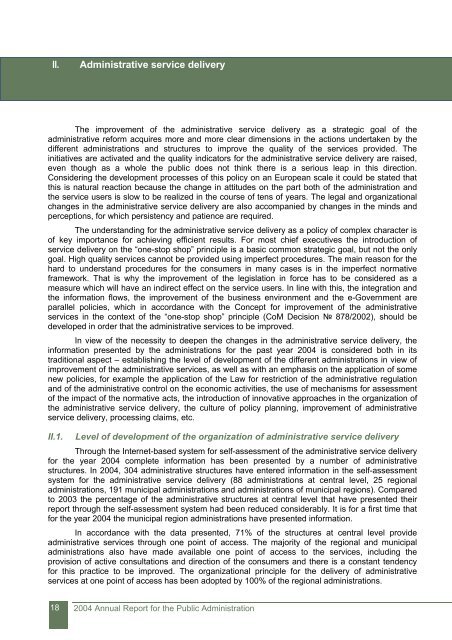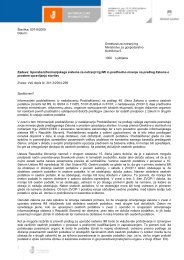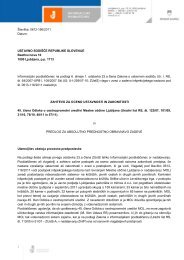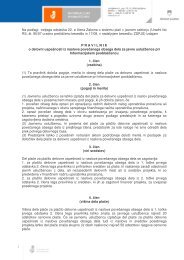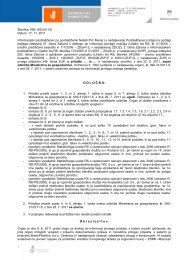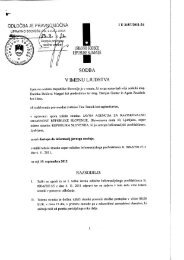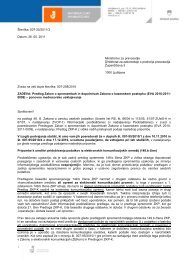Annual Report for the Public Administration 2004
Annual Report for the Public Administration 2004
Annual Report for the Public Administration 2004
Create successful ePaper yourself
Turn your PDF publications into a flip-book with our unique Google optimized e-Paper software.
II.<br />
Administrative service delivery<br />
The improvement of <strong>the</strong> administrative service delivery as a strategic goal of <strong>the</strong><br />
administrative re<strong>for</strong>m acquires more and more clear dimensions in <strong>the</strong> actions undertaken by <strong>the</strong><br />
different administrations and structures to improve <strong>the</strong> quality of <strong>the</strong> services provided. The<br />
initiatives are activated and <strong>the</strong> quality indicators <strong>for</strong> <strong>the</strong> administrative service delivery are raised,<br />
even though as a whole <strong>the</strong> public does not think <strong>the</strong>re is a serious leap in this direction.<br />
Considering <strong>the</strong> development processes of this policy on an European scale it could be stated that<br />
this is natural reaction because <strong>the</strong> change in attitudes on <strong>the</strong> part both of <strong>the</strong> administration and<br />
<strong>the</strong> service users is slow to be realized in <strong>the</strong> course of tens of years. The legal and organizational<br />
changes in <strong>the</strong> administrative service delivery are also accompanied by changes in <strong>the</strong> minds and<br />
perceptions, <strong>for</strong> which persistency and patience are required.<br />
The understanding <strong>for</strong> <strong>the</strong> administrative service delivery as a policy of complex character is<br />
of key importance <strong>for</strong> achieving efficient results. For most chief executives <strong>the</strong> introduction of<br />
service delivery on <strong>the</strong> “one-stop shop” principle is a basic common strategic goal, but not <strong>the</strong> only<br />
goal. High quality services cannot be provided using imperfect procedures. The main reason <strong>for</strong> <strong>the</strong><br />
hard to understand procedures <strong>for</strong> <strong>the</strong> consumers in many cases is in <strong>the</strong> imperfect normative<br />
framework. That is why <strong>the</strong> improvement of <strong>the</strong> legislation in <strong>for</strong>ce has to be considered as a<br />
measure which will have an indirect effect on <strong>the</strong> service users. In line with this, <strong>the</strong> integration and<br />
<strong>the</strong> in<strong>for</strong>mation flows, <strong>the</strong> improvement of <strong>the</strong> business environment and <strong>the</strong> e-Government are<br />
parallel policies, which in accordance with <strong>the</strong> Concept <strong>for</strong> improvement of <strong>the</strong> administrative<br />
services in <strong>the</strong> context of <strong>the</strong> “one-stop shop” principle (CoM Decision № 878/2002), should be<br />
developed in order that <strong>the</strong> administrative services to be improved.<br />
In view of <strong>the</strong> necessity to deepen <strong>the</strong> changes in <strong>the</strong> administrative service delivery, <strong>the</strong><br />
in<strong>for</strong>mation presented by <strong>the</strong> administrations <strong>for</strong> <strong>the</strong> past year <strong>2004</strong> is considered both in its<br />
traditional aspect – establishing <strong>the</strong> level of development of <strong>the</strong> different administrations in view of<br />
improvement of <strong>the</strong> administrative services, as well as with an emphasis on <strong>the</strong> application of some<br />
new policies, <strong>for</strong> example <strong>the</strong> application of <strong>the</strong> Law <strong>for</strong> restriction of <strong>the</strong> administrative regulation<br />
and of <strong>the</strong> administrative control on <strong>the</strong> economic activities, <strong>the</strong> use of mechanisms <strong>for</strong> assessment<br />
of <strong>the</strong> impact of <strong>the</strong> normative acts, <strong>the</strong> introduction of innovative approaches in <strong>the</strong> organization of<br />
<strong>the</strong> administrative service delivery, <strong>the</strong> culture of policy planning, improvement of administrative<br />
service delivery, processing claims, etc.<br />
II.1.<br />
Level of development of <strong>the</strong> organization of administrative service delivery<br />
Through <strong>the</strong> Internet-based system <strong>for</strong> self-assessment of <strong>the</strong> administrative service delivery<br />
<strong>for</strong> <strong>the</strong> year <strong>2004</strong> complete in<strong>for</strong>mation has been presented by a number of administrative<br />
structures. In <strong>2004</strong>, 304 administrative structures have entered in<strong>for</strong>mation in <strong>the</strong> self-assessment<br />
system <strong>for</strong> <strong>the</strong> administrative service delivery (88 administrations at central level, 25 regional<br />
administrations, 191 municipal administrations and administrations of municipal regions). Compared<br />
to 2003 <strong>the</strong> percentage of <strong>the</strong> administrative structures at central level that have presented <strong>the</strong>ir<br />
report through <strong>the</strong> self-assessment system had been reduced considerably. It is <strong>for</strong> a first time that<br />
<strong>for</strong> <strong>the</strong> year <strong>2004</strong> <strong>the</strong> municipal region administrations have presented in<strong>for</strong>mation.<br />
In accordance with <strong>the</strong> data presented, 71% of <strong>the</strong> structures at central level provide<br />
administrative services through one point of access. The majority of <strong>the</strong> regional and municipal<br />
administrations also have made available one point of access to <strong>the</strong> services, including <strong>the</strong><br />
provision of active consultations and direction of <strong>the</strong> consumers and <strong>the</strong>re is a constant tendency<br />
<strong>for</strong> this practice to be improved. The organizational principle <strong>for</strong> <strong>the</strong> delivery of administrative<br />
services at one point of access has been adopted by 100% of <strong>the</strong> regional administrations.<br />
18<br />
<strong>2004</strong> <strong>Annual</strong> <strong>Report</strong> <strong>for</strong> <strong>the</strong> <strong>Public</strong> <strong>Administration</strong>


